First Act Adam Levine Double Cut Solid Body Electric Guitar Review
Larn the story behind First Deed''s Custom partitioning and the artists they build guitars for
Click here to see a photo gallery of some of Starting time Act'due south wildest custom guitars.
If you're an avid PG reader, you might exist wondering just why we accept a feature story on Offset Human activity guitars. Well-nigh of you (and myself included) are accepted to high-end instruments, a nomenclature that doesn't really apply to guitars that are readily available for purchase at your local Target store. Notwithstanding the First Deed make name doesn't end there. Over the past year, every bit nosotros've visited with numerous and varied artists for our Rig Rundown serial of videos, a mutual thread kept popping up: elaborate (and sometimes foreign) First Human action-branded guitars in the hands of major players. Information technology might come up as a surprise that the First Act brand really goes much farther than your kid's first guitar.
Based in Boston, the First Act Custom Shop has been in business since 2002. Headed by industry-veterans Jimmy Archey [Managing director of Creative person Relations] and John McGuire [Chief Luthier], their piddling shop of rockers has a very all-encompassing build resume for some of the biggest names in rock, both mainstream and underground. The duo, along with their squad of builders, have constructed pieces for artists equally varied as The Cure, Maroon 5, Paul McCartney, Drive-By Truckers, Mastodon, Ministry, Aerosmith, and Bon Jovi. I caught upward with both Jimmy and John to discuss their build process, the growing involvement in their custom creations, and the joys of being able to pattern custom guitars for lesser-known acts.
How did the First Human activity Custom Shop get off of the ground?
McGuire: Back in 2002, the company came up with the plan to offset an actual luthier store, initially for more than of a marketing focus. They wanted to become some artists playing guitars with the Starting time Act name. They approached Kelly Butler, who was the Chief Luthier up until three years agone, and he started putting together the store one or two pieces at a time. Initially, Kelly took on apprentices from the Roberto Venn Luthiery School to build the team. Jimmy came on board not too long after that.
Archey: Yes, I came on in 2003. Essentially what they said was that they wanted to use the store every bit a marketing tool for brand awareness, and go some absurd artists playing some cool guitars. Information technology was a great manner to just go the name out, for people that may not know the name, and to become a buzz running.
McGuire: The promise was that if the younger crowd saw some of their favorite bands playing the guitars, that it would assist get them involved in playing music, as well.
It seems like there are two divisions of First Human action: one that produces the entry-level, section store guitars, and another for what you guys exercise in the Custom Shop. Are you guys pretty much given gratuitous reign to accept on projects that y'all desire to do?
McGuire: For the most function, they pretty much leave u.s. alone. At that place'southward still the prototyping element that we accept to practice now and once more, just they're been really good to u.s.a. in letting u.s.a. motion in whatever direction that we've wanted to. I wouldn't say nosotros're 2 divide entities, considering we're ever a part of them.
Archey: I'll essentially go artists and compile an artist spec canvass, and send information technology in to the store when I feel similar we're done with it. They really trust what we're doing, because we've proven to them that the people that we're going later and the people that we've gotten are hit a mark. I get and then many telephone calls and emails proverb, "Dude, I saw and so-and-so with a custom First Act, I love that guitar." There'south a lot of interaction from the public to u.s. that is kind of reinforcing what nosotros're doing, y'all know? We're getting out to a younger crowd, which is exactly what we wanted to practice.
At the same time, we designed a guitar with Adam [Levine] from Maroon five, and he was totally integral in designing that guitar that he'southward playing, then it turns effectually and becomes the footing for a line at Target. We do take a crossover, but mostly this little thing that we're doing allows u.s.a. to move on our own.
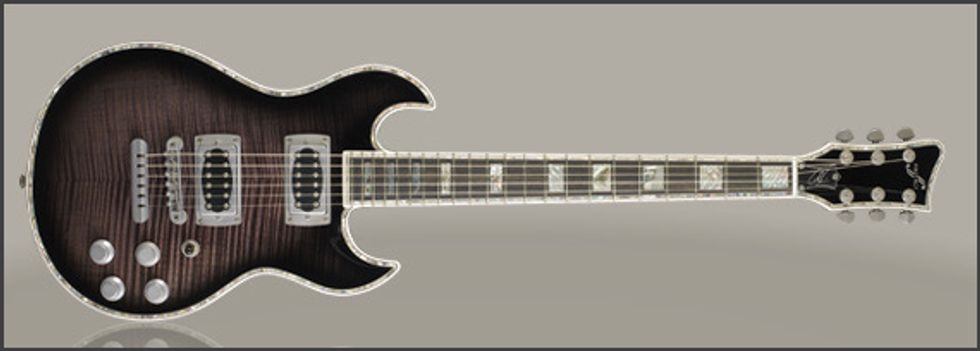
Adam Levine's Custom Double Cutaway with Commencement Act loftier-output humbuckers and flame maple top.
So, how did the both of yous go into the luthier business organization?
McGuire: I was basically born into the business concern. My dad owned Valley Arts Guitars. Eventually, we ended up moving to Tennessee, where he worked for Gibson. Once I finished loftier school, I followed suit past going to piece of work for Gibson and attention schoolhouse for CAD layout and design. After school, I started working at the applied science department in the Gibson Custom Shop. I worked there at Gibson for a full of 10 years, with nigh four of those years in the engineering science side. I eventually became the Special Projects Manager at the Custom Shop and was in charge of all of the Fortune 500 guitars, NASCAR trophy guitars--stuff like that. Effectually 2004, I fabricated it up to Boston and got started with Outset Act'southward Custom Store.
Archey: I got my first as a sound human out in the Philadelphia area. Eventually, I made my way out to New York City, where I got offered a consultant job for Gibson. It was one day a calendar week, bringing bands in. It turned into a total-time job, and I was there from 1989 to 2003 as the artist relations guy in the New York City office. For almost 14 years, I worked with Les Paul, Joe Perry, and BB Male monarch, to name a few. I took a chore thinking that I was going to go dorsum out on the road, and and so information technology just stuck. Around 2003, I was up in Boston and Kelly called me up, asking me if I wanted to come by and check out his shop. I swung by that day, and a couple of weeks later I started working with him.
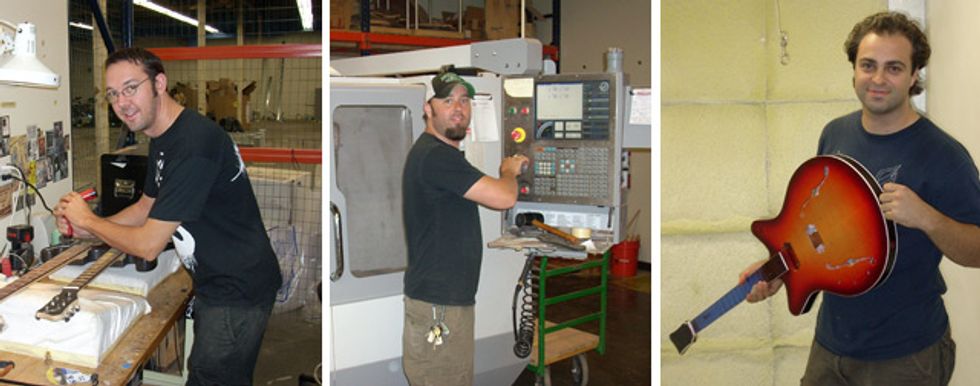
(left) Robert White, (centre) John McGuire, (right) Chris Moncada
How many luthiers work at the Custom Shop?
McGuire: Our build squad includes four other guys. Bill Jancr and Christopher Moncada both went to the Bryan Galloup Guitar School in Michigan, and Bill as well worked at Gibson for a couple of years. Eric Dueset basically came to the states off of the street--he had congenital a couple of custom basses that were really cool. He came from a carpenter background and but wowed us. Robert White came to us from Roberto Venn.
What'south the procedure with artist models? Do you lot apply any of the design principles from your previous work?
McGuire: Well, what we make, in the stop, is really upon creative person request. The 1 thing that nosotros're still doing that'south very of import to u.s. is that everything is all hand fabricated. Obviously, a lot of united states came from Gibson, but there are things that are dissimilar, such as the neck pitch. Again, it really does depend on what the artist wants, only they usually request the standard mahogany body with a maple cap. We practise a lot of that. That hasn't stopped us from trying different things, though. Several of our carved top solidbodies have ended upwards being all ash, ash with maple, and other combinations of woods. We take besides congenital with more exotic woods, like koa, zebrawood, you name it.
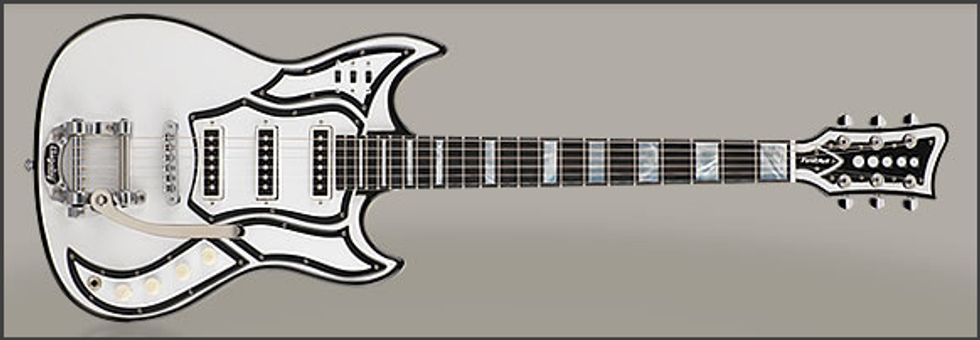
Nick McCarthy'due south Custom First Act
Archey: Artist requests are really fun to work with. When nosotros first started, we didn't accept any models or designs to work from. Nick [McCarthy] from Franz Ferdinand essentially went to pawn shops, proverb, "I dig this body, I dig the mode this and that looks," and we would then piece all of the ideas together. He wanted it covered in white vinyl cobra skin, and then Bill figured out a fashion to do it without the material shrinking and showing the edges, and it turned out pretty crazy.
McGuire: Information technology'south really a really absurd guitar. Pictures really don't do information technology justice--it'south really a sight to behold.
Archey: Another really cool one was one we built for Brad Rice, who plays in Keith Urban'south band. It'due south a Delia LS with a Lollar P90 in the bridge and a Lollar Charlie Christian in the neck. He handed us a stack of hotel keycards, and Neb cut upwardly all of the keycards to class a mosaic on the height of the guitar and on the headstock. It took forever, but ended upward being really cool looking. Bill manus to hand-cut every single little hotel key.
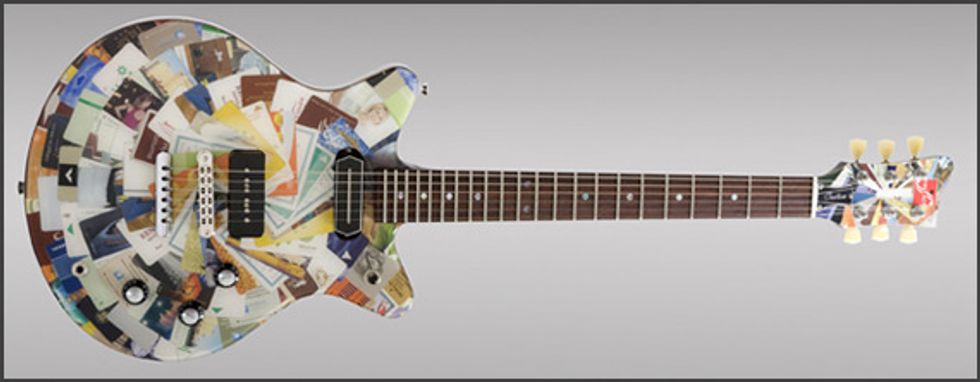
Brad Rice's Hotel Primal Delia LS
There aren't a lot of limits to what y'all guys build.
McGuire: Nosotros actually have a pretty broad scope of artist guitars, ranging from the untraditional look and appeal of Matt Pike'due south 9-string [a double-cutaway where the pinnacle three strings are doubled like a 12-string], to stuff that's more reminiscent of traditional instruments.
We accept some models that we exercise every so often that are really truthful players' guitars, models with multiple pickup selections, no heel construction--features like those. One we phone call the Session Series Sheena, and the PB5, which is a full rocker guitar. Information technology has a Floyd Rose and a two-humbucker configuration with a coil tap, pretty much all of the bells and whistles that a difficult rocker would want.
We requite the aforementioned treatment to our basses, too. Steve Jenkins [solo artist] just got a Session Series model, kind of a counterpart to the Sheena. We put a video game button on his wired to a kill switch so he could employ fast tremolo effects. We're very proud that we work all across the board, making guitars for what anybody thinks is absurd.
What pickups are the guitars normally fitted with?
Archey: Nosotros similar to use Kent Armstrongs, unless the artist is endorsing another product. We'll throw in EMGs or Seymour Duncans in sometimes. If they supply their own pickups, we'll put them in there, besides. Some people take their own preferences.
You guys have built several models for bigger contour acts, such as Rick Nielsen of Cheap Trick and Perry Bamonte of The Cure. But at the aforementioned time, in that location's a big underground rock focus also.
Archey: Absolutely. I of the coolest parts of the task is getting to build guitars for bands that we all really like. When we started out, we went after what we considered to be the hipper, younger bands at the time. With what the chief part of the company is making, generally kids are going to want to buy those guitars, So we figured information technology was a skillful idea to go subsequently those bands the younger oversupply will go see, and see them playing a First Deed.
Also, a lot of what nosotros've been able to practise snowballed from the work that we did with bands early on. We got hundreds of bands [interested] because of Kurt Ballow from Converge. He normally doesn't lend his name to too many brands, he plays what he likes, and he usually plays information technology forever. Steve Pedulla from Thursday and Nick Zinner from the Yeah Yeah Yeahs were huge, besides. Our Delia model is based on the guitar that nosotros designed with Nick.
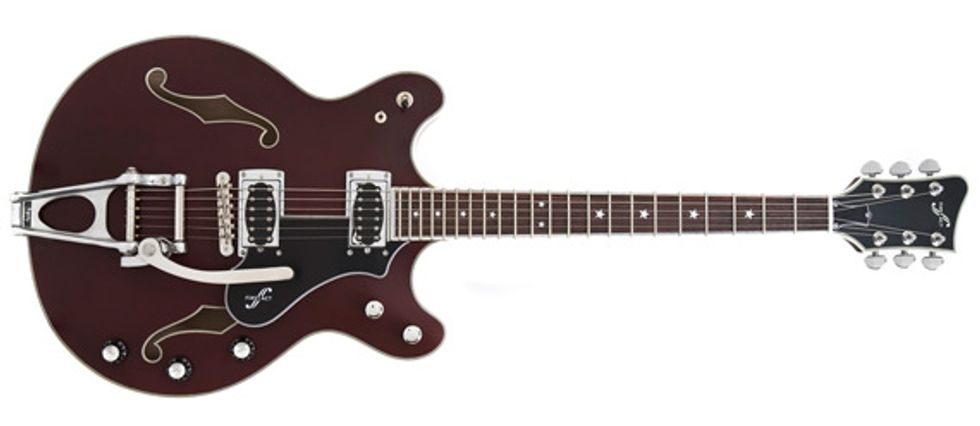
Nick Zinner'south latest guitar, dubbed the Fuzzaxe has a congenital-in fuzz circuit.
In improver to the Delia, how many different model types do y'all guys offer?
McGuire: As far equally the limited editions go, we actually have five total. The Lola is a pretty straightforward rock guitar, with a askew mahogany body and a depression profile span. The Sheena is a single cutting, alder-bodied guitar with a half-dozen-in-line headstock. The Delia and Delia LS are our semi-hollow models. Finally, there'south the Delgada model, which has an offset body fashion, and is also available in a bass class. Of class, we do numerous torso shapes and styles for artists when requested.
Tell us about some of those.
McGuire: The first guitar that we built for Brent Hinds [Mastodon], a double cutaway model with the offset lower horn, is one of them.
Archey: Some other one is the dual guitar-bass that we built for Takeshi from Boris. I'grand a huge Boris fan, and they wanted to come past when they were in the New York area a while back. I said, "Absolutely!" [laughs] He literally came by with mechanical drawings from a friend of his in Japan of what he roughly wanted.
McGuire: Roughly? I wouldn't say that!
Archey: [laughs] Yeah, they were really expressionless-on diagrams. Nosotros had to tweak it a little bit, and we likewise had to downsize the scale slightly. He'south like, 5'7" and 100 pounds sopping moisture. I think it came out bully.
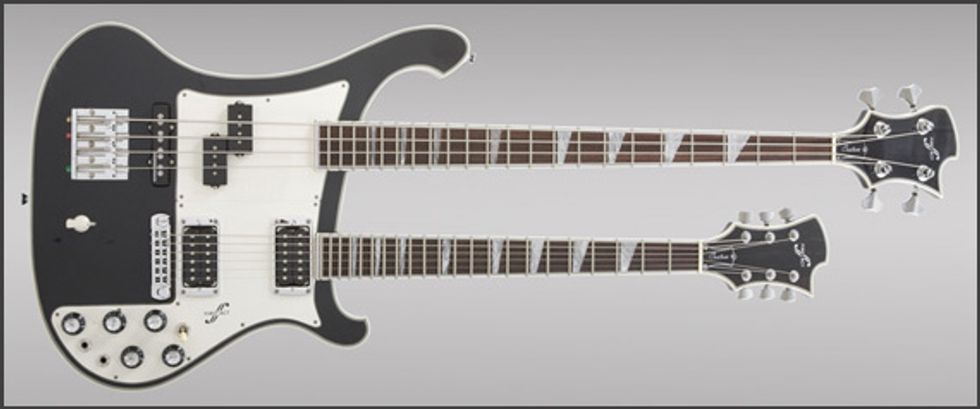
The Boris guitar-bass doubleneck
Out of all of the custom instruments that you guys have had a hand in, what are your personal favorites?
Archey: That's tough, there are so many adept ones. Well, equally a bass player, I love the Takeshi [Boris] double-cervix, and I similar the Kelson Louis [Future Of The Left] Delia LS bass. Guitar-wise, I'thou kind of leaning towards the recent one that we did for Steve Pedulla [Th], which was a hollowbody, offset doublecut monster. Those are my few that stand out right now.
McGuire: For me, I'd have to say the doublecut, 9-string carved top that we did with Matt State highway is 1 of my favorites. That i in particular is ane that will e'er stick in my head. When he was telling united states what he wanted, it was nigh surreal. I had ever wanted to practise something for the guy, and I've been listening to his music since I discovered his onetime band Slumber in high school. And then that whole state of affairs of talking about what he wanted in a guitar, while he's telling us that he's eating a steak with his bare easily, was actually strange.
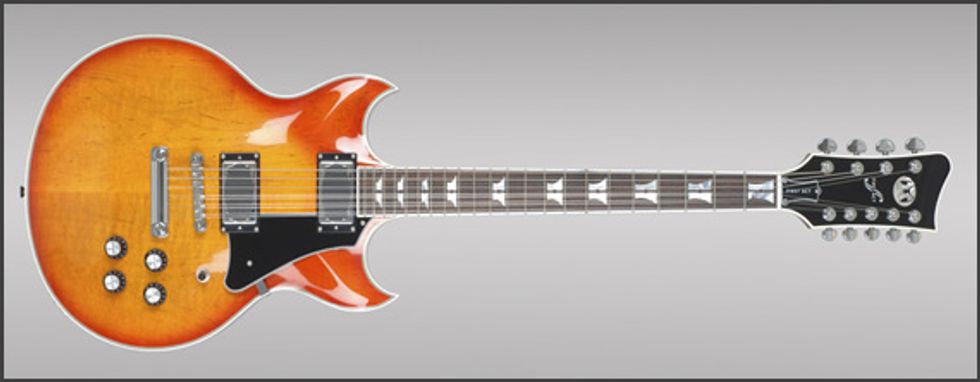
Matt State highway's 9-String Double Cutting
I really wanted him to play what we made for him, and I was a fiddling worried that he wouldn't after a while. That guitar, with 3 doubled high strings, is the kind of thing that some people would effort once then put in the closet. We put a lot of work into that 1, from redesigning the cease bar and making adjustments to our original doublecut, carved top design. It'south too one of those things where, being that nosotros'll build what you desire, you've got to be a little careful in what y'all say. Office of that conversation with him was, "I like a heavy guitar dude...make it real heavy." And then, we did. He never did once complain about it, and I've got to mitt it to him. He turned information technology into his principal axe.
Archey: I retrieve that we've done so well considering nosotros're but having a blast doing it.
McGuire: Oh yeah. I mean, even before we were working with Mastodon and High On Fire, it was slap-up just beingness asked what artist I wanted to build for.
Archey: That's one of the coolest things about being here, that everyone is pretty involved. Half the time, I'll go up to ane of the luthiers and enquire them what their favorite band is, or what they're listening to that they're really into correct now. After that, we'll get later them and see if they want a guitar. Information technology kind of keeps everything as a little community within our shop, and makes the guys feel really good because they go to build something for somebody that they really like.
How long does ane of these custom guitars take, on boilerplate?
McGuire: You know, it varies. It'south usually anywhere between half dozen weeks and iv months, depending on how many artists and customers are already in line for a guitar, and the time we spend prototyping stuff.
Can a non-touring guitarist club a custom build?
Archey: We're totally open up to anybody wanting a guitar. Simply go in touch with us and we'll talk.
How would ane get nearly doing that?
Archey: If a player is interested, they can contact us through the Customer Service page on our website, and John will work with them to get a price quote out. They tin also email me at JArchey@firstact.com if they have any questions.
mastersonthavall87.blogspot.com
Source: https://www.premierguitar.com/gear/builder-profile-first-act-custom-shop
0 Response to "First Act Adam Levine Double Cut Solid Body Electric Guitar Review"
Post a Comment